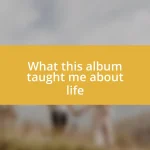Key takeaways:
- The evolution of crime fiction reflects societal changes, with an increasing focus on complex characters, especially anti-heroes and multifaceted female protagonists.
- Reader demographics significantly influence preferences, with younger audiences favoring tech-savvy narratives, while older readers may lean toward traditional storytelling styles.
- Integrating technology and psychological depth into writing enhances storytelling, making it more relatable and engaging for contemporary readers.
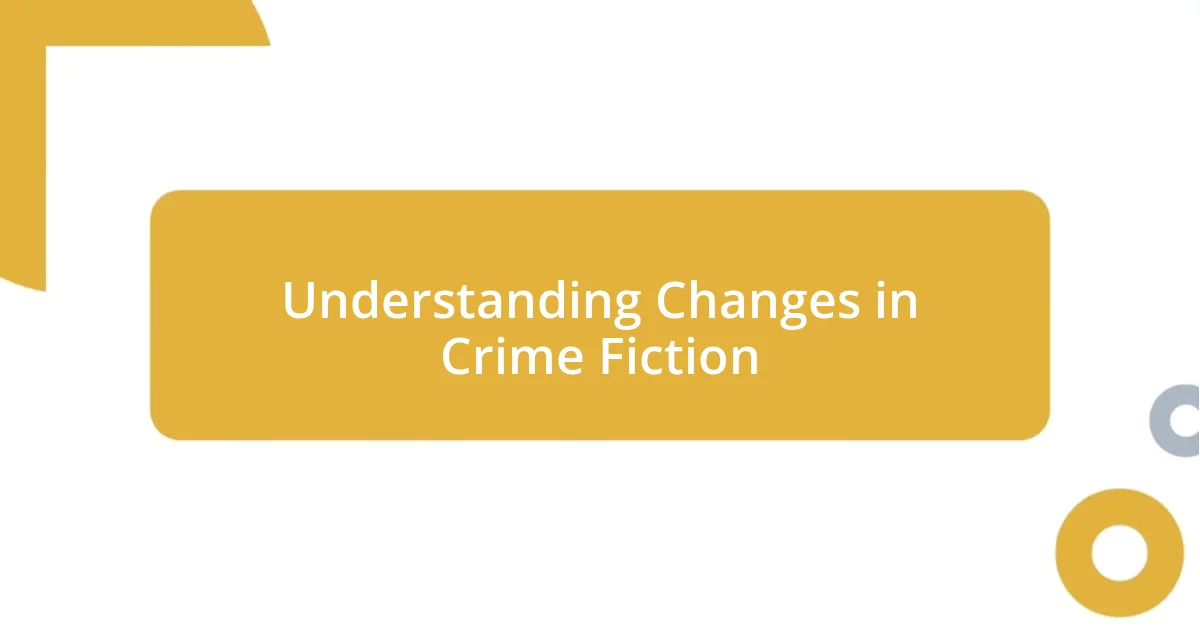
Understanding Changes in Crime Fiction
Understanding the shifts in crime fiction really hits home for me. I remember when I first read a classic detective novel, completely captivated by the traditional plot twists. But as I explored modern works, I found myself drawn to narratives that delve deeper into psychological landscapes—what happened to the simple whodunit that once left me so enchanted?
As society evolves, so does crime fiction. The themes we explore reflect our collective anxieties and cultural shifts. I often ask myself, why are we so fascinated by anti-heroes today? Perhaps it’s because they mirror the complex realities we face, making us question morality and justice in ways that earlier narratives didn’t.
The emergence of technology has also transformed the genre in fascinating ways. The thrill of a high-tech heist or the implications of cybercrime injects a new level of urgency into storytelling. I recall the gripping sensation I felt while reading a recent thriller; it resonated not just as entertainment but as a reflection of the world we live in, highlighting how our fears and challenges are woven into the fabric of contemporary crime fiction.
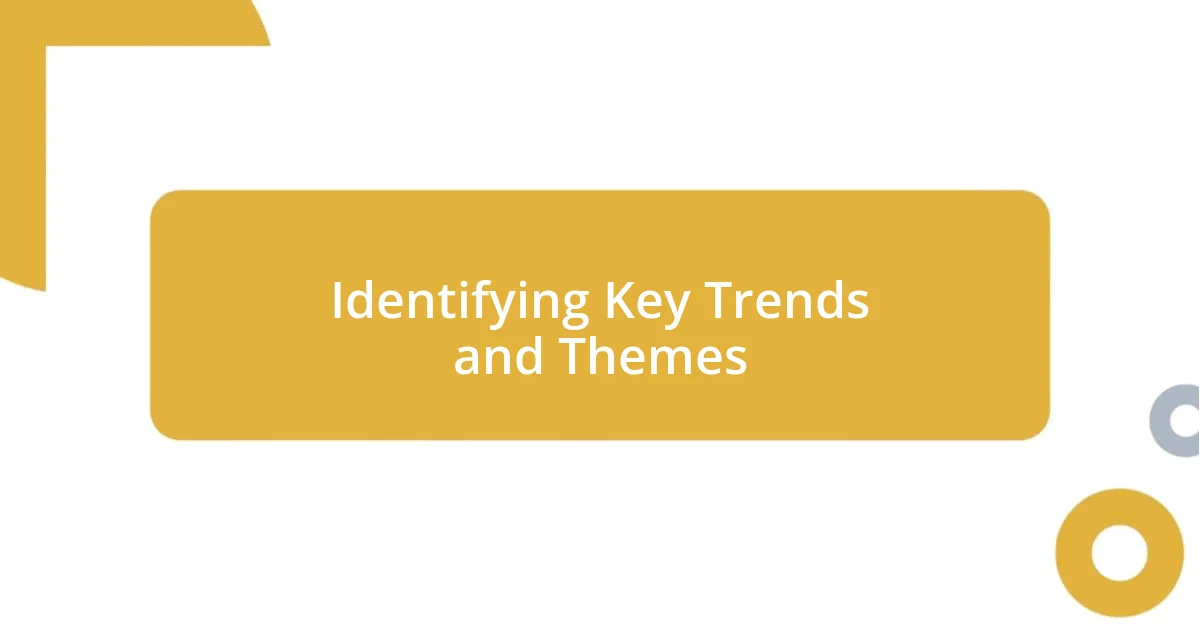
Identifying Key Trends and Themes
Identifying key trends and themes in crime fiction is like uncovering layers of a captivating puzzle. One significant trend is the increasing portrayal of complex female characters. I remember being particularly struck by a novel where the female protagonist wasn’t just an accomplice or romantic interest—she was the mastermind. It challenged my expectations and highlighted a refreshing shift towards equality and depth in character development.
Another striking theme is the intersection of crime and social issues, particularly around systemic injustices. In one book I read, the murder mystery unraveled into a poignant commentary on race and class. It left me thinking for days about the societal implications, revealing how crime fiction can serve as a mirror to our reality, pushing readers to consider uncomfortable truths.
Lastly, mental health topics are becoming more prominent in crime narratives, often driving the motivations behind criminal behavior. A recent thriller I encountered had a deeply flawed detective whose struggles with anxiety added layers to the plot. This nuanced portrayal made me appreciate how writers are not only crafting compelling stories but also sparking important conversations about mental health.
| Trend | Description |
|---|---|
| Complex Female Characters | Women as multifaceted protagonists and not just sidekicks. |
| Social Issues | Crime narratives reflecting societal injustices and inequalities. |
| Mental Health | Exploration of psychological struggles influencing criminal behavior. |
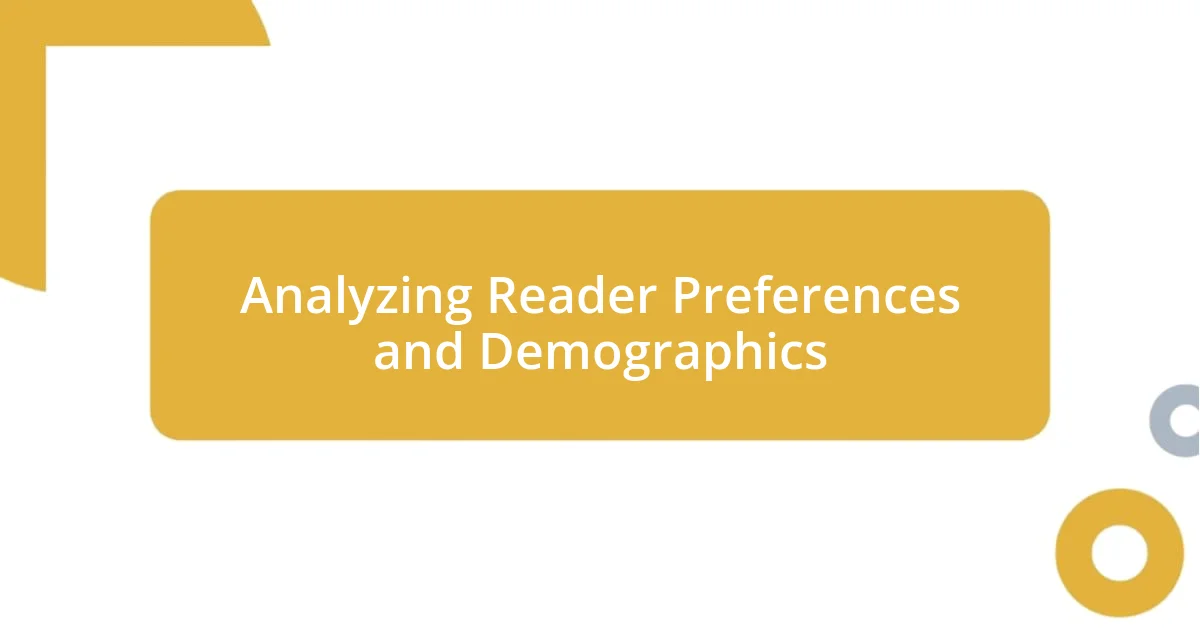
Analyzing Reader Preferences and Demographics
When I look at reader preferences in crime fiction, it’s fascinating to see how demographics shape our tastes. For instance, younger readers often gravitate toward fast-paced narratives with a tech-savvy twist. I remember discussing this phenomenon with some friends who prefer books that incorporate social media and cyber themes—it’s as if they crave a mirror reflecting their digital-age experiences. Those conversations opened my eyes to how age and lifestyle influence our choices in literature.
I’ve also noticed how gender can play a role in what captivates readers. Here’s a quick overview of those distinctions:
- Male Readers: Often drawn to traditional tropes like the hard-boiled detective and intricate plots centered on mystery.
- Female Readers: Increasingly favor narratives that explore relationships and psychological depth, often preferring complex character development.
- Younger Readers (18-34): Seek thrillers that intertwine technology with crime, reflecting their digital lifestyles and real-world anxieties.
- Older Readers (35+): May prefer classic styles and themes that evoke nostalgia, enjoying the time-tested elements of suspense and intrigue.
This dynamic interplay of preferences reveals a lot about our collective psyche and societal shifts, shaping how we engage with the genre.
Diving deeper into demographics, I’ve witnessed firsthand how reader backgrounds influence anticipation. Readers from urban environments, for example, might be drawn to gritty realism that resonates with their everyday experiences. I remember picking up a crime novel set in a bustling city, and it felt as though I was walking those streets, intensifying my connection to the story.
Here are some details on how geographical factors might affect preferences:
- Urban Readers: Typically enjoy stories with a fast pace and relatable settings, often reflecting crime in city life.
- Rural Readers: Prefer narratives that explore simpler, more intimate mysteries, perhaps highlighting community dynamics and personal relationships.
- Cultural Influences: Regional factors can lead to variations in storytelling styles, with some cultures embracing folklore elements in crime stories.
These nuances in reader demographics create a rich tapestry of what we find engaging in crime fiction. It’s a constant reminder of how the world around us crafts the stories we love.
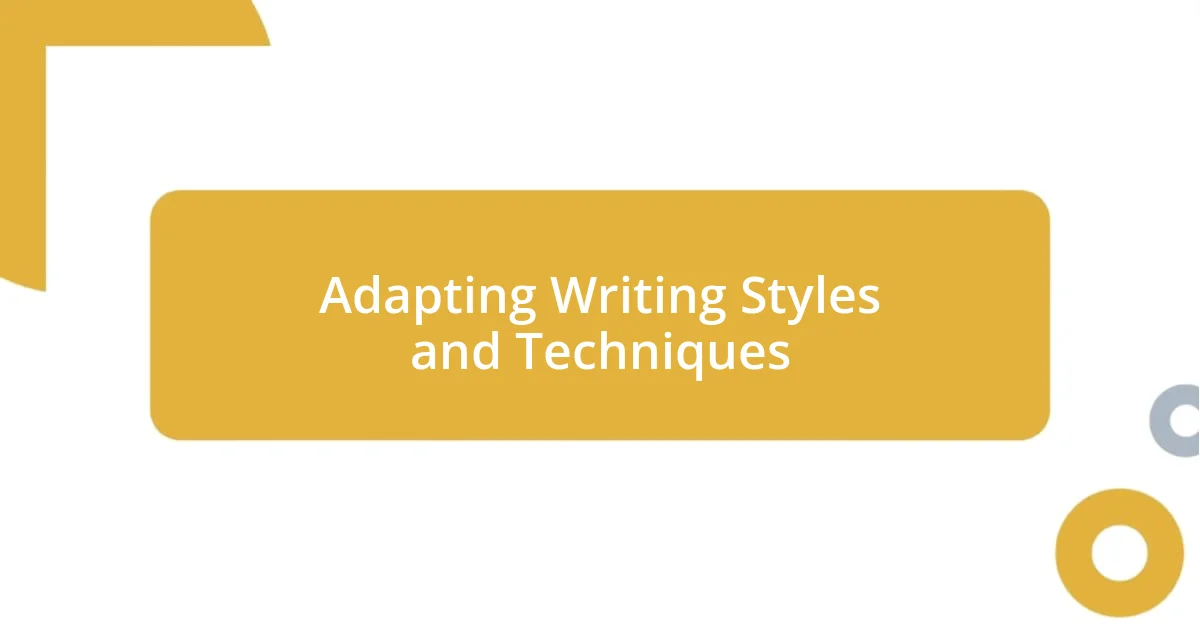
Adapting Writing Styles and Techniques
Adapting my writing style to the evolving landscape of crime fiction has been a fascinating journey. For instance, I once struggled to integrate modern slang and tech references into my work, fearing it might alienate some readers. However, after engaging with younger audiences at a book club, I discovered how much they enjoyed relatable, contemporary dialogue. It opened my eyes to the importance of connecting with readers on their level—embracing change can breathe new life into narratives.
As crime fiction shifts towards deeper character exploration, I’ve found myself leaning more into psychological complexity. A notable experience was writing a short story about a detective wrestling with guilt over a past case. Digging into his psyche not only challenged my writing techniques but also made me realize how engaging it can be to vividly paint a character’s internal struggle. It struck me: how can a story resonate if we don’t let our readers into our characters’ minds?
Furthermore, incorporating varied narrative structures has allowed me to keep pace with genre innovations. I recall trying out non-linear timelines in a mystery I was crafting. Initially, it felt disorienting, but the payoff was thrilling. The challenge taught me that as long as the story remains clear and engaging, experimenting with forms can create intricate layers that captivate readers. Have you ever tried breaking from traditional storytelling? If not, I highly recommend it—it’s a liberating experience that could reshape your approach to writing.
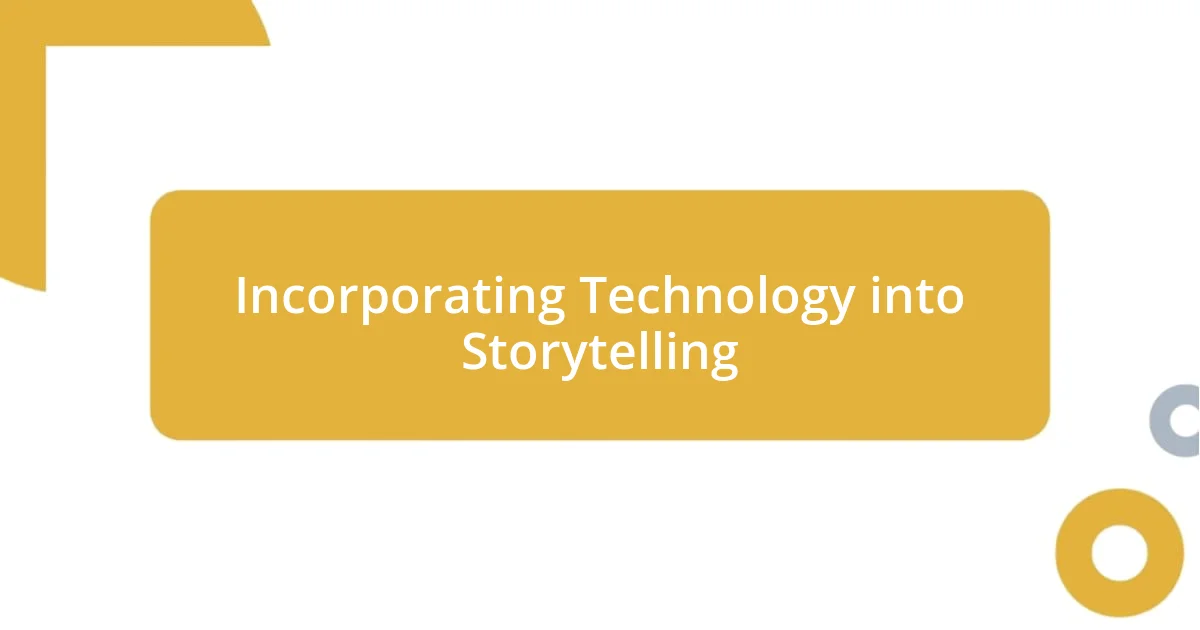
Incorporating Technology into Storytelling
Incorporating technology into storytelling is essential for resonating with today’s readers. I remember crafting a story that featured a tech-savvy hacker who became a pivotal character in unraveling the mystery. It was an eye-opener; reflecting on my own experiences with technology, I realized how integral it is to our lives now. How can we ignore an aspect that shapes our daily interactions?
Moreover, I’ve experimented with integrating social media platforms within my plots, a trend I’ve seen gaining traction. One time, I wrote a short story where a detective used a Twitter feed to piece together clues. It not only elevated the suspense but also highlighted the immediacy and chaos of information overload. Have you thought about how your characters could leverage technology to drive the narrative? Using real-life tools can make the story feel both contemporary and authentic.
As I’ve navigated the intricacies of tech in storytelling, I’ve also felt a responsibility to stay updated. Attending workshops on cybercrime opened my eyes to the nuances of hacker culture and digital ethics. It made me realize that bringing accurate technology into my plots isn’t just entertaining—it’s also a chance to educate my readers. It’s not easy, but isn’t that what makes the challenge worthwhile?

Building Engaging Characters and Plots
Building engaging characters and plots starts with diving into the emotional core of the characters I create. I recall developing a protagonist haunted by a family tragedy, which fueled his obsessive quest for justice. Connecting with my own vulnerabilities made his pain more palpable, and I found that readers resonate with characters that embody real emotions—how often do we see ourselves in their struggles?
Plotting, on the other hand, must intertwine cleverly with character development. In one of my recent novels, I crafted a narrative where the plot was driven by the protagonist’s moral dilemmas. As he faced ethical choices, I realized the story became a reflection of his growth. Have you ever noticed how a character’s decisions can elevate the stakes of a plot? It’s fascinating to see how engaging plots can emerge from the conflicts our characters endure, seamlessly propelling the narrative forward.
Finally, I’ve learned that pacing is crucial in maintaining reader interest. I once experimented with alternating points of view, which allowed me to build suspense as different characters unveiled pieces of the puzzle. The thrill of doing that felt electric—did it ever occur to you how shifting perspectives can breathe life into your story? It’s as if every chapter offers a new lens through which readers can explore the unfolding drama, keeping them eager for what comes next. Each twist not only propels the plot but also deepens our understanding of the characters involved, making the journey more rewarding.





